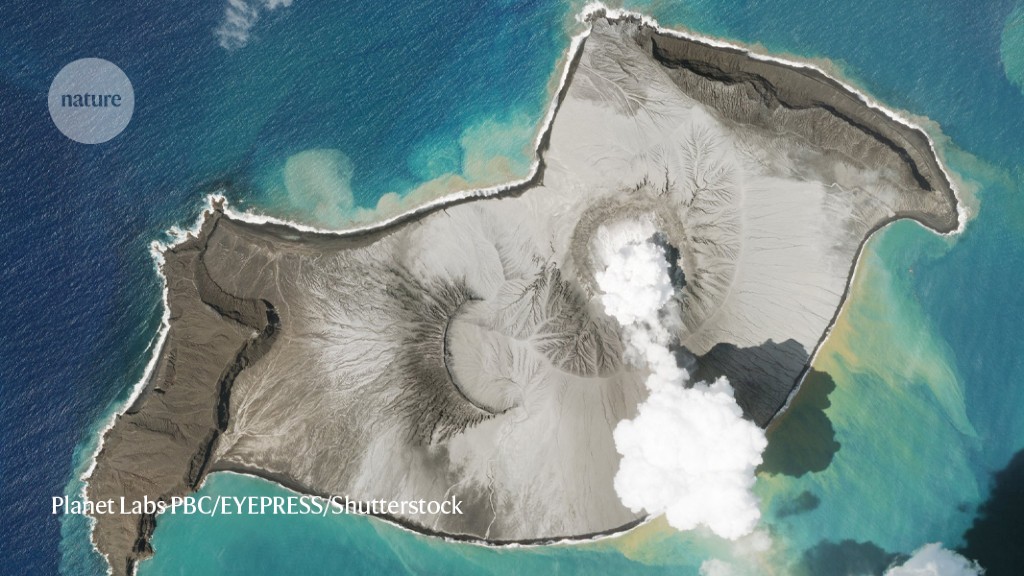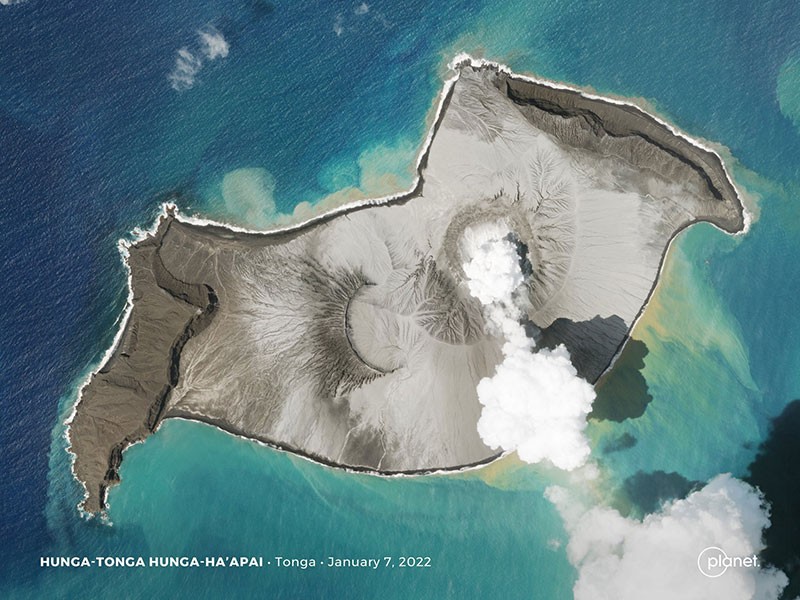How the Tonga eruption is helping space scientists to understand Mars
NASA scientists say that the eruption of a submarine volcano in Tonga is helping them to understand how certain features formed on the surfaces of Mars and Venus.
The unusual explosion of the Hunga Tonga–Hunga Ha‘apai volcano has been calculated at more than 500 times the force of the atom bomb dropped on Hiroshima, Japan, in 1945.
Studying the volcano and its evolution in recent weeks is “important for planetary science”, says Petr Brož, a planetary volcanologist at the Institute of Geophysics of the Czech Academy of Sciences in Prague. The knowledge “might help us to reveal results of water–lava interactions on the red planet and elsewhere across the Solar System”, he says.
The volcanic island, which began to form from ash and lava expelled from an undersea volcano in early 2015, piqued the interest of researchers including James Garvin, chief scientist at NASA’s Goddard Space Flight Center in Greenbelt, Maryland, because of its similarity to structures on Mars and possibly Venus. “We don’t normally get to see islands form,” explains Garvin, but this one offered “a front-row seat”.
Volcanic islands typically last for just months before being eroded away. But Hunga Tonga–Hunga Ha‘apai survived for years, allowing Garvin’s team to use satellite observations and sea-floor surveys to study how such islands form, erode and persist. The researchers wanted to use that knowledge to understand how small conical volcanoes found on Mars might have formed in the presence of water billions of years ago.
Many volcanoes on Mars are thought to have erupted with steady flows of lava, but some could have been explosive, like Hunga Tonga–Hunga Ha‘apai, says Joseph Michalski, a planetary scientist at the University of Hong Kong.
The marine environment also mimics some aspects of the low-gravity settings on small planets such as Mars and “can shed unique light on Martian features that formed in lower gravity”, he adds.
How does Omicron spread so fast? A high viral load isn’t the answer
Around the world, Omicron has rapidly become the dominant SARS-CoV-2 strain. Now, two studies show that the variant has achieved success despite causing viral levels in the body that are similar to — or lower than — those of its main competitor, the Delta variant (J. A. Hay et al. Preprint at medRxiv https://doi.org/hdgg (2022); O. Puhach et al. Preprint at medRxiv https://doi.org/hdgh; 2022).
The results suggest that Omicron’s hyper-transmissibility does not stem from the release of large amounts of virus from infected people, but from its ability to evade SARS-CoV-2 immunity caused by either vaccination or past infection, says Emily Bruce, a virologist at the University of Vermont in Burlington. Previous research has hinted that Delta leads to a higher ‘viral load’, the amount of virus in an infected person, than other variants. This is often measured using a polymerase chain reaction (PCR) test, which provides an index of the quantity of viral RNA in the body.
To compare the variants’ viral loads, Yonatan Grad, an infectious-disease specialist at the Harvard T. H. Chan School of Public Health in Boston, Massachusetts, and his co-authors drew on test results of the staff members at the National Basketball Association, the organization responsible for professional basketball in North America. The researchers studied PCR-test results of swabs collected from infected players and personnel. Those who had Delta had a slightly higher peak viral load than did those with Omicron. “I was really not expecting to see that,” says Grad. After all, in only two months, Omicron had replaced Delta as the dominant cause of US COVID-19 cases.
Benjamin Meyer, a virologist at the University of Geneva in Switzerland, says that he, too, was stunned by Grad’s results. “Naturally, you’d think that higher transmissibility must cause a higher viral load,” he says.
Rather than measuring only viral RNA, Meyer and his colleagues assessed the number of infectious virus particles on swabs collected from a separate group of almost 150 infected people. This more stringent method found no significant difference between the viral loads of vaccinated individuals infected with Omicron and those infected with Delta.
The studies have not yet been peer reviewed.




More News
Author Correction: Bitter taste receptor activation by cholesterol and an intracellular tastant – Nature
Audio long read: How does ChatGPT ‘think’? Psychology and neuroscience crack open AI large language models
Ozempic keeps wowing: trial data show benefits for kidney disease